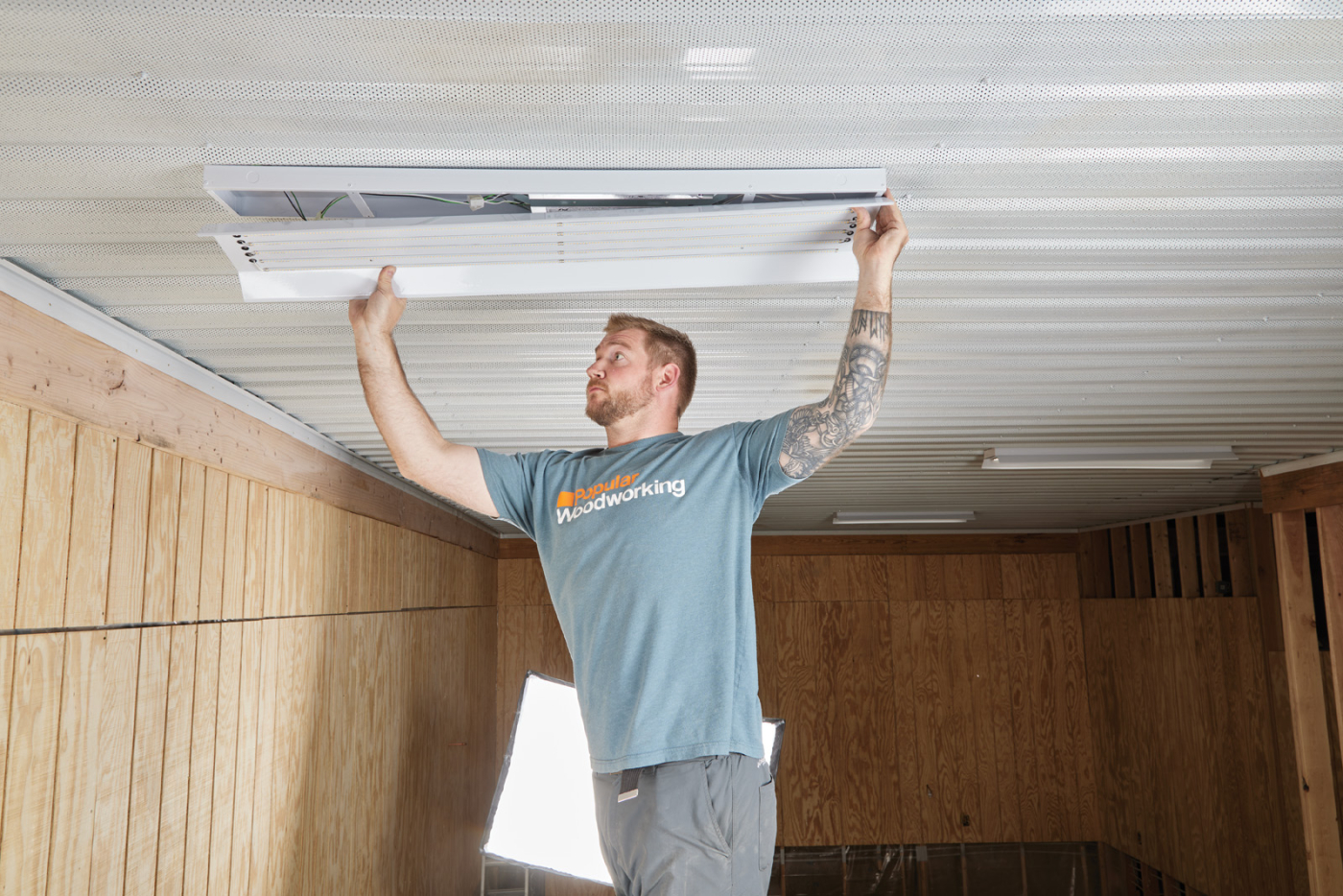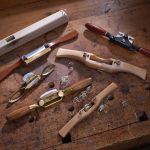We may receive a commission when you use our affiliate links. However, this does not impact our recommendations.
 Upgrade your shop lighting to help you see what you are working on and to make your shop more inviting.
Upgrade your shop lighting to help you see what you are working on and to make your shop more inviting.
Did you know that at age 60, you need approximately 3x the amount of light to see as you did at age 20? Lighting is, I think, something that most of use take for granted. Just jump on Amazon and order some or run to Home Depot and grab the highest lumen 5000K lights that they have in stock, right? Well, I thought so too—at least until I started planning the lights that we’d need in our new Popular Woodworking shop. When I started researching lighting, I came across the company American Green Lights, and upon browsing their website, I realized that there’s so much more that goes into properly lighting a woodworking space than just hanging up lights. So, I reached out to Jim Uno, the president of American Green Lights to pick his brain on shop lighting, and to order lights for our shop. (And no, this is not sponsored by American Green Lights in any way—I just like their products, services, and support).
Importance of Lighting
I think that the importance of good shop lighting cannot be overstated. Being able to see what you’re working on is crucial to being able to make accurate parts. In some instances, proper lighting may reveal some things that your wish it hadn’t— a dent here, or those milling marks that you thought you had gotten out. Plus, with the proper lighting, your shop will feel much brighter and will lead to less eye strain.

While appearing similar, the difference between LED and fluorescent fixtures is drastic, and worth the investment.
Good Light
When we start talking about lighting, we really need to consider what makes good light? In reality, the purpose of the room which you’re lighting will dictate what makes “good” light. But, in the woodworking shop we’re looking for a few things:
First, we’re looking for even light—everywhere you work, you want a consistent amount of light and to not cast shadows on your workpieces.
Next, we want to have a bright, but not too bright, light. We need to be able to see what we’re working on, see layout lines, etc. However, lights shouldn’t be so bright that they cause eye strain.
Finally, lights should not effect color of items in the room. Rather, lights should show colors as they are, instead of giving a color cast to the items they shine on. This may not seem important, but as you’re trying to match wood tones, you’ll see why this is important.
Types of Fixtures
Before we talk about designing a shop lighting system and choosing lights, let’s first make sure we’re all on the same page with the types of lights available. I’m sure you’re familiar with incandescent bulbs—an incandescent bulb passes power through a resistor (the filament). As the resistor heats up, it glows and produces light.
Now, most of the working world has shifted away from incandescent bulbs, at least in a work setting. Instead, the industry has given way to two different types of fixtures over the years. You can see these earlier in the article — fluorescent fixtures (bottom ) and more recently, LED fixtures (top).
Fluorescent fixtures consist of a ballast that regulates the flow of power to the fluorescent tubes. They provide the correct amount of power to start it, and the correct amount to keep the tube lit. The fluorescent tube is a glass tube containing some nasties—mercury, phosphorous, and an inert gas. The power supplied through the electrodes causes the mixture of elements to glow (in layman’s terms). This is important to remember for later.

The internal works of an LED fixture may look like a fluorescent, but they have different functions.
A LED fixture on the other hand looks similar to a fluorescent, but instead of a ballast and tubes, it contains a driver and several strips of LEDs. The driver converts the AC current from your house and turns it into DC power. This low-amp power illuminates the LEDs. As a side note—there are other types of LEDs. Those that screw into incandescent fixtures, UFO (round) lights, etc. For this article, we’ll concentrate on the Fluorescent style ones—simply because they give a more even light that is hard to block with your body (causing a shadow).
The Amount of Light
Now, let’s dig into some of the things that will effect the lights in our shop. Starting with the power of the lights, and how we measure that. I’m sure that most of you are familiar with the light measurement called “lumens.” A lumen is the measure of how much visible light a fixture (or bulb) produces. While this is a good measurement to know—it’s only half of the puzzle. It reality, you should only care about how much of that light reaches your working level.
This is where we need to understand the idea of foot-candles (fc). A foot-candle is defined as one lumen per square feet (65 foot-candles would measure as 65 lumens per square foot). This is the more important measurement, because it gives us an actual way to measure how much light reaches us as we work. Think of it this way—you could have a one-million lumen light bulb, but it doesn’t do good if it’s 50 miles away.
So how many foot candles do you need? That all depends on what task you’re doing. A classroom, for example, will need about 30-50fc. An average residential garage is between 5 and 15fc. For a woodworking shop, the IES (Illuminating Engineering Society—yes, that’s a thing) states you should shoot for 60-100fc. For reference, an overcast day (with no shadow from the sun) is about 900-1200fc. (Your eyes truly do an amazing job adjusting for various light conditions). Understand that the higher wattage a fixture, the more powerful it is.
Color
The final thing to look at with lights is going to be the color of the lights. This is a two-fold item though—you want to not only look at the color temperature of the light (K), but also the fixture’s CRI—the color rendering index.

The K value of a light tells you what color the fixture emits. A 5K light is neutral colored, while 1K is yellow and 10‚000K is blue.
Lights always have a color value assigned to them. The color of the lights is expressed as a Kelvin value. I’m sure you’ve seen this when buying lights. As you can see above, the lower the K value, the more yellow the light is. The higher the value, the more blue it is. In your house, you may have a warm, inviting 2700 to 3500k light. But in the shop, we want to have a 5000k color. This is the most neutral of all of the colors.

In operation, fluorescent and LED lights will render colors differently. The color gamut above shows the amount of each wavelength the lights emit.

These images show the difference between a photo taken with fluorescent and LED tubes. While these are photos, your eyes pick up the difference in color as easily as a camera lens does.
TOP: 95 CRI PerformaLUX shop light, BOTTOM: 85 CRI Fluorescent tube
The second half of the color puzzle is the CRI of the light, or the color rendering index. Warning—a large portion of my college career was focusing on color theory, so I can get really nerdy on color. The CRI is a measurement of how many colors are visible under the light fixture. To wrap your head round this, you have to first come to understand that you see color based on wavelengths. If a light source emits zero green wavelengths, nothing will appear green (it will appear a shade different than green). The diagram above shows color gamuts for two different lights. You’ll notice that the high CRI LED Light emits a full spectrum of light, instead of only spikes of certain colors. Remember the nasties I said fluorescent bulbs contain? Each compound adds a little color, depending on the compound. The compound that creates green light is cheap, so the tubes generally contain a lot of it. Likewise, the compounds that produce the red light waves are expensive, so there are fewer of them within the tube. A real-life example of this can be seen to the right—notice how the top image appears much more “real.” The fluorescent is missing a lot of red light waves and the hand appears sickly and pale. This is particularly importance when working with wood or finishes that has rich tones, such as mahogany, walnut, cherry, etc.
Build a Plan
So, how does all of this come together to get you a good set of lights in your shop? Well, this is where American Green Lights steps in. The folks over at American Green Lights will take your shop layout and build you a lighting model. This is a service they offer hobbyist for free (they do charge industrial clientele for this service, as they’re more complex). When I reached out to Jim, he asked me to send him a rendering of our new shop, so I sent him a rough sketchup model of the space.
What Jim and his team does is rebuild this in a lighting simulation software—they’re looking to hit that 60-100fc level everywhere in the shop. See the light intensity map below. This is a model that allows you to see how fixtures will light a space, and how much overlap or there will be between fixtures (or where there may not be enough light). While it may be hard to read on a small screen, there are number that represent the FC ratings at working level. They range from about 40-96. Of course, there’s a little variance through the space—light is concentrated around the workbench, table saw, and various other “tool spots.” By contrast, you can see the lower level of lighting that’s been positioned in the office and the restroom—there’s a much lower lighting requirement for those spaces.

The model American Green Lights produced for our shop shows fixtures placed around tool locations. The goal is that the working level is between 60-100 fc, while the floor may be closer to 40-50.
For our particular shop, American Green Lights suggested a series of 10, 144-watt fixtures, supplemented by two 48-watt fixtures. These are commercial, higher powered lights, as we have a 14′ ceiling in the shop—most home shops would be lower wattage lights as the ceilings are lower. Even though these are “high-bay” style lights (high watt), they don’t take a ton of power. With all of the lights on, they draw 12amps, which is pretty dang good considering the size of the space.

These photos compare the same items under the American Green Light LED shop lights vs. fluorescent lamps. The left and middle photos use the same camera setting for both our LED and the old fluorescent lamps. The 2 fluorescent photos are the same except the F-Stop is adjusted to compensate for the lower light levels of the fluorescent.
Now, we have a unique situation in our shop—it’s being built from the ground up, so these were new installs. We bought the entire fixture from the American Green Lights. However, if you already have some form of fluorescent or LED lights in your shop, and you want to upgrade, American Green Lights offers retrofit kits that will fit in old fixtures. In fact, the retro lights from American Green Lights are super low-profile. So, if you work in a basement shop that has low ceilings, you can actually install the strips directly to the bottom of a joist and save yourself a lot of room.
Of course, as you might expect, lights from American Green Lights are more expensive than going to the big-box store. The thing that is important to remember is that not all LEDs are created equal. Cheap LEDs can have low CRI values, they may flicker (which will really effect video quality if that’s your thing), and cheaper lights could be considered disposable — once a part goes bad, there’s no support for the product.
American Green Lights toured over four hundred factories until they decided one was up to their quality needs, in both parts and manufacturing. Because of the quality of the parts, the lights from American Green Lights will last—unlike the phony light ratings on bulbs from the store. And, serving large industrial and commercial clients, they stock parts to repair lights (in case a driver goes out), and their customer service is second to none. If you’re working in a cave of a workshop, and are ready to do yourself a favor, consider upgrading your shop lights — I think that your eyes will thank you.
Here are some supplies and tools we find essential in our everyday work around the shop. We may receive a commission from sales referred by our links; however, we have carefully selected these products for their usefulness and quality.



 Upgrade your shop lighting to help you see what you are working on and to make your shop more inviting.
Upgrade your shop lighting to help you see what you are working on and to make your shop more inviting.




